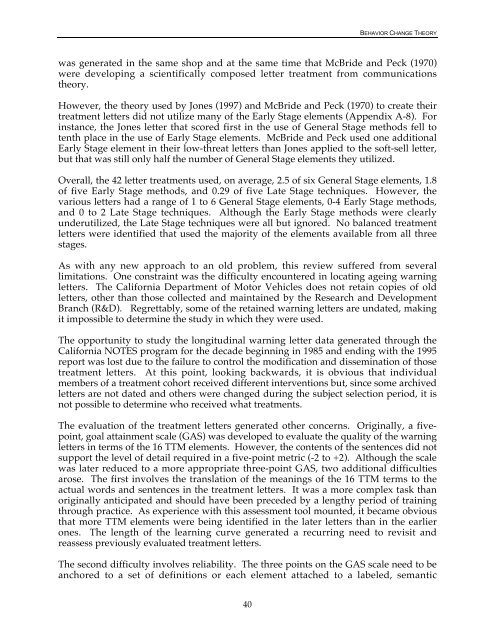Application of Behavior Change Theory to the Development
Application of Behavior Change Theory to the Development
Application of Behavior Change Theory to the Development
Create successful ePaper yourself
Turn your PDF publications into a flip-book with our unique Google optimized e-Paper software.
40<br />
BEHAVIOR CHANGE THEORY<br />
was generated in <strong>the</strong> same shop and at <strong>the</strong> same time that McBride and Peck (1970)<br />
were developing a scientifically composed letter treatment from communications<br />
<strong>the</strong>ory.<br />
However, <strong>the</strong> <strong>the</strong>ory used by Jones (1997) and McBride and Peck (1970) <strong>to</strong> create <strong>the</strong>ir<br />
treatment letters did not utilize many <strong>of</strong> <strong>the</strong> Early Stage elements (Appendix A-8). For<br />
instance, <strong>the</strong> Jones letter that scored first in <strong>the</strong> use <strong>of</strong> General Stage methods fell <strong>to</strong><br />
tenth place in <strong>the</strong> use <strong>of</strong> Early Stage elements. McBride and Peck used one additional<br />
Early Stage element in <strong>the</strong>ir low-threat letters than Jones applied <strong>to</strong> <strong>the</strong> s<strong>of</strong>t-sell letter,<br />
but that was still only half <strong>the</strong> number <strong>of</strong> General Stage elements <strong>the</strong>y utilized.<br />
Overall, <strong>the</strong> 42 letter treatments used, on average, 2.5 <strong>of</strong> six General Stage elements, 1.8<br />
<strong>of</strong> five Early Stage methods, and 0.29 <strong>of</strong> five Late Stage techniques. However, <strong>the</strong><br />
various letters had a range <strong>of</strong> 1 <strong>to</strong> 6 General Stage elements, 0-4 Early Stage methods,<br />
and 0 <strong>to</strong> 2 Late Stage techniques. Although <strong>the</strong> Early Stage methods were clearly<br />
underutilized, <strong>the</strong> Late Stage techniques were all but ignored. No balanced treatment<br />
letters were identified that used <strong>the</strong> majority <strong>of</strong> <strong>the</strong> elements available from all three<br />
stages.<br />
As with any new approach <strong>to</strong> an old problem, this review suffered from several<br />
limitations. One constraint was <strong>the</strong> difficulty encountered in locating ageing warning<br />
letters. The California Department <strong>of</strong> Mo<strong>to</strong>r Vehicles does not retain copies <strong>of</strong> old<br />
letters, o<strong>the</strong>r than those collected and maintained by <strong>the</strong> Research and <strong>Development</strong><br />
Branch (R&D). Regrettably, some <strong>of</strong> <strong>the</strong> retained warning letters are undated, making<br />
it impossible <strong>to</strong> determine <strong>the</strong> study in which <strong>the</strong>y were used.<br />
The opportunity <strong>to</strong> study <strong>the</strong> longitudinal warning letter data generated through <strong>the</strong><br />
California NOTES program for <strong>the</strong> decade beginning in 1985 and ending with <strong>the</strong> 1995<br />
report was lost due <strong>to</strong> <strong>the</strong> failure <strong>to</strong> control <strong>the</strong> modification and dissemination <strong>of</strong> those<br />
treatment letters. At this point, looking backwards, it is obvious that individual<br />
members <strong>of</strong> a treatment cohort received different interventions but, since some archived<br />
letters are not dated and o<strong>the</strong>rs were changed during <strong>the</strong> subject selection period, it is<br />
not possible <strong>to</strong> determine who received what treatments.<br />
The evaluation <strong>of</strong> <strong>the</strong> treatment letters generated o<strong>the</strong>r concerns. Originally, a fivepoint,<br />
goal attainment scale (GAS) was developed <strong>to</strong> evaluate <strong>the</strong> quality <strong>of</strong> <strong>the</strong> warning<br />
letters in terms <strong>of</strong> <strong>the</strong> 16 TTM elements. However, <strong>the</strong> contents <strong>of</strong> <strong>the</strong> sentences did not<br />
support <strong>the</strong> level <strong>of</strong> detail required in a five-point metric (-2 <strong>to</strong> +2). Although <strong>the</strong> scale<br />
was later reduced <strong>to</strong> a more appropriate three-point GAS, two additional difficulties<br />
arose. The first involves <strong>the</strong> translation <strong>of</strong> <strong>the</strong> meanings <strong>of</strong> <strong>the</strong> 16 TTM terms <strong>to</strong> <strong>the</strong><br />
actual words and sentences in <strong>the</strong> treatment letters. It was a more complex task than<br />
originally anticipated and should have been preceded by a lengthy period <strong>of</strong> training<br />
through practice. As experience with this assessment <strong>to</strong>ol mounted, it became obvious<br />
that more TTM elements were being identified in <strong>the</strong> later letters than in <strong>the</strong> earlier<br />
ones. The length <strong>of</strong> <strong>the</strong> learning curve generated a recurring need <strong>to</strong> revisit and<br />
reassess previously evaluated treatment letters.<br />
The second difficulty involves reliability. The three points on <strong>the</strong> GAS scale need <strong>to</strong> be<br />
anchored <strong>to</strong> a set <strong>of</strong> definitions or each element attached <strong>to</strong> a labeled, semantic
















